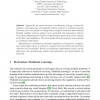120 search results - page 20 / 24 » Evolutionary Methods in Self-organizing System Design |
GECCO
2007
Springer
14 years 2 months ago
2007
Springer
The topological properties of a network directly impact the flow of information through a system. For example, in natural populations, the network of inter-individual contacts aff...
BERTINORO
2005
Springer
14 years 2 months ago
2005
Springer
Fractal proteins are an evolvable method of mapping genotype to phenotype through a developmental process, where genes are expressed into proteins comprised of subsets of the Mande...
ECAL
2005
Springer
14 years 2 months ago
2005
Springer
Abstract. Inspired by the recent advances in evolutionary biology, we have developed a self-organising, self-adaptable cellular system for multitask learning. The main aim of our p...
ATAL
2005
Springer
14 years 2 months ago
2005
Springer
Reinforcement learning problems are commonly tackled with temporal difference methods, which use dynamic programming and statistical sampling to estimate the long-term value of ta...
IE
2007
13 years 10 months ago
2007
Images are widely used in media contexts such as web design, games and video animation. The process of creating interesting images can be enjoyable if a useful tool is involved. I...

